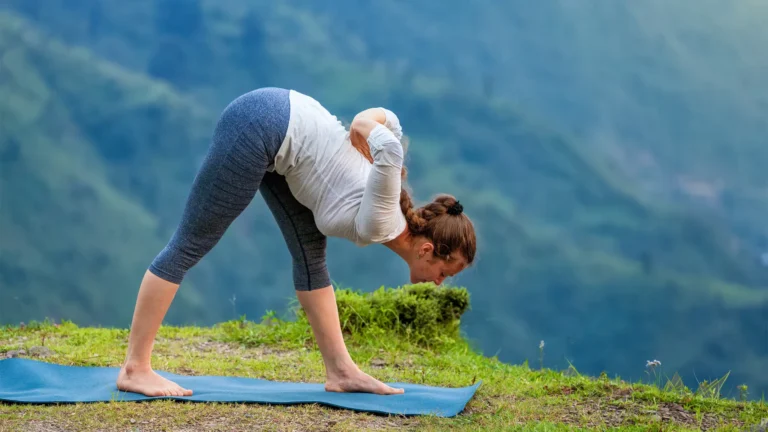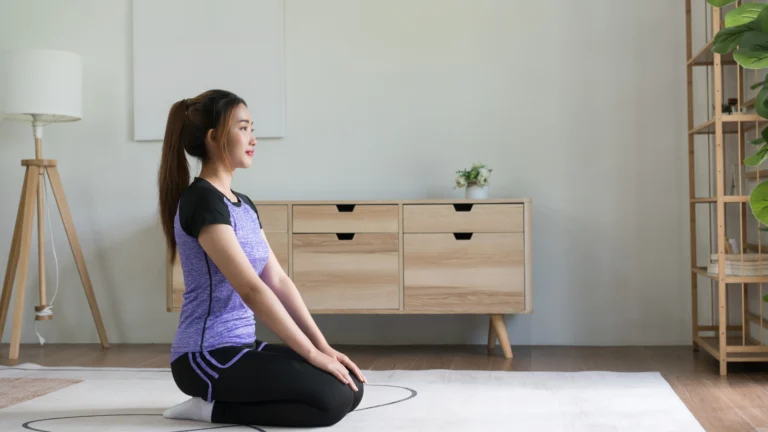Malasana-Garland Pose: Steps, Benefits, and Cautions
Welcome to our deep dive into Malasana, also known as the Garland Pose or Yogi Squat! If you’re looking to enhance your yoga practice with a pose that combines strength, flexibility, and balance, you’ve come to the right place. Malasana might not always be the star of the show in online yoga classes, but it’s a gem when it comes to building a strong foundation for your practice. In this guide, we’ll explore how to perform Malasana, its incredible benefits, and some important cautions to keep in mind. Ready to squat your way to better health? Let’s dive in!
What is Malasana?
Malasana, or Garland Pose, is a deep squat that’s often seen in various yoga styles and practices. The name comes from the Sanskrit words “mala,” meaning garland, and “asana,” meaning pose. Imagine a garland of flowers draped around your neck—that’s the kind of deep, open, and rounded shape your body creates in this pose.
This squat isn’t just about getting low; it’s about finding strength and flexibility in a natural position that’s often overlooked in modern life. Malasana is a pose that’s both grounding and energizing, and it can serve as a powerful tool for improving your overall yoga practice and well-being.
Steps to Perform Malasana

1. Begin in a Standing Position
Start by standing with your feet about hip-width apart. You can also turn your toes out slightly, depending on what feels most natural for you. This stance helps you find balance and stability as you move into the squat.
2. Engage Your Core
Engage your core muscles to help support your lower back as you prepare to squat down. A strong core will give you more control and stability throughout the pose.
3. Lower into a Squat
Slowly begin to bend your knees and lower your hips toward the ground. Keep your chest lifted and your back straight. It’s okay if you don’t get all the way down at first—just go as low as your flexibility and comfort allow.
4. Place Your Hands in a Prayer Position
Once you’re in the squat, bring your hands to your heart center in a prayer position. Press your palms together to help open up your chest and keep your spine long. This also helps deepen the stretch in your hips.
5. Use Your Elbows for Leverage
Gently press your elbows against your inner knees to open up your hips even further. This helps to maintain proper alignment and can deepen the stretch if you’re comfortable doing so.
6. Hold and Breathe
Hold the pose for several breaths, allowing your body to relax and sink deeper into the squat with each exhale. Aim for a duration that feels comfortable, typically around 30 seconds to a minute.
7. Rise Slowly
To come out of the pose, press your feet into the ground and slowly rise back up to standing. Take a moment to shake out your legs and gently stretch your muscles after holding the pose. The longest duration of holding Malasana is 20 minutes.
Benefits of Malasana
Malasana is more than just a squat—it’s a powerhouse of benefits for both the body and mind. Here’s why you might want to incorporate it into your routine:
1. Improves Flexibility
Malasana is excellent for improving flexibility in the hips, groin, and lower back. By regularly practicing this pose, you can increase your range of motion in these areas, which is beneficial for other yoga poses and everyday activities. To further enhance your flexibility, online yoga classes for flexibility can be incredibly valuable. Many platforms offer specialized classes and programs that focus on flexibility, incorporating poses like Malasana to help you achieve greater mobility and strength.
2. Strengthens Lower Body
This pose engages and strengthens the muscles in your legs, including your quadriceps, hamstrings, and calves. It also helps to build strength in your core and lower back, providing a solid foundation for other movements.

3. Enhances Balance
Balancing in Malasana requires a combination of strength and flexibility. Regular practice helps improve your overall balance and stability, which can enhance your performance in other yoga poses and physical activities.
4. Aids Digestion
The deep squat position can stimulate the digestive organs and help relieve issues like constipation. It’s a great pose to include in your routine if you’re looking to support your digestive health.
5. Promotes Relaxation
Despite its challenging nature, Malasana can be quite calming. The focus on breathing and the deep, grounding position can help reduce stress and promote relaxation. It’s a great pose to practice after a long day or as part of your wind-down routine.
6. Supports Posture
Regular practice of Malasana can help improve your posture by strengthening your core and opening up your hips. This can lead to better alignment and less strain on your back and shoulders throughout the day.
Cautions and Modifications
While Malasana is a fantastic pose, it’s important to approach it with mindfulness, especially if you’re new to it or have specific physical limitations. Here are some cautions and modifications to consider:
1. Knee and Ankle Sensitivity
If you have sensitive knees or ankles, be gentle when moving into and holding the pose. You might want to place a folded blanket or towel under your heels to provide additional support and reduce strain on your joints.
2. Lower Back Discomfort
If you experience discomfort in your lower back, focus on engaging your core and maintaining a long spine throughout the pose. Avoid rounding your back, and consider using a yoga block under your seat for added support if needed.
3. Hip Flexibility
If you have tight hips and find it challenging to lower into the squat, start by practicing a modified version. Try placing a block or bolster under your seat while you squat to provide support and gradually work on deepening the pose as your flexibility improves.
4. Pregnancy
Pregnant individuals should approach Malasana with caution and consult their healthcare provider before practicing. Modifications and alternative poses may be more suitable during pregnancy.
5. Consult a Professional
If you have any existing injuries or medical conditions, it’s always best to consult with a healthcare professional or a qualified yoga instructor before attempting new poses. They can provide personalized guidance and modifications based on your individual needs.
Similarly, you can also check out our blog “Shirshasana – Headstand Pose: Steps, Benefits, and Cautions”
Integrating Malasana into Your Practice
Malasana is a versatile pose that can be incorporated into various parts of your yoga practice.

Here are a few ideas for integrating it into your routine:
As a Warm-Up
Use Malasana as a warm-up to prepare your hips, legs, and core for more challenging poses. It’s a great way to loosen up and get your body ready for deeper stretches and more intense movements.
In a Sequence
Include Malasana in a sequence of poses that focus on flexibility and strength. For example, you might pair it with poses like Downward Dog, Warrior II, and Pigeon Pose for a well-rounded practice.
As a Restorative Pose
Practice Malasana as a restorative pose in a sequence designed to calm and relax the body. Hold the pose for a longer duration and focus on deep, mindful breathing to promote relaxation and stress relief.
In Daily Life
Beyond your formal yoga practice, try incorporating Malasana into your daily life. Use it as a way to stretch and strengthen your legs and hips while you’re watching TV, reading, or doing other activities at home.
Boosts Digestive Efficiency Naturally
The deep squat of Malasana compresses and massages the abdominal region, stimulating digestion and detoxification. A clinical review found that squatting-based postures, like Malasana, can reduce constipation and improve bowel movement efficiency by up to 50% compared to seated positions, Practicing Malasana regularly can therefore be a natural aid for gut health.
Boosts Pelvic Floor Strength
Malasana naturally engages the pelvic floor muscles, which are crucial for core stability and overall functional health. This makes it especially beneficial for women postpartum, athletes, or anyone looking to improve bladder control and lower abdominal strength. By practicing Garland Pose regularly, you strengthen these often-overlooked muscles, which can enhance endurance, stability, and overall confidence in daily movement.
Encourages Mind-Body Grounding
This deep squat is not only a physical posture but also an energetic one. Sitting close to the earth in Malasana creates a grounding effect, helping practitioners feel more centered and connected to the present moment. Many yogis use this pose during mindfulness or meditation practices because it calms racing thoughts and fosters inner stillness. It’s a powerful reminder that balance comes from being rooted in both body and mind.
Supports Natural Mobility and Longevity
In many cultures, deep squatting is a natural resting position, but modern lifestyles often cause us to lose this mobility. Practicing Malasana restores this functional movement pattern, which supports joint health and mobility into later years of life. Studies on populations that sit in deep squats daily show improved hip and knee health compared to those who don’t. Incorporating Malasana into your practice can, therefore, be a long-term investment in maintaining flexibility and ease of movement as you age.
Conclusion
Malasana, or Garland Pose, is a wonderful addition to any yoga practice. It offers a wealth of benefits, from improved flexibility and strength to enhanced balance and digestion. By following the steps outlined in this guide, and being mindful of the cautions and modifications, you can enjoy all that Malasana has to offer.
Remember, yoga is a journey, and each pose is an opportunity to learn more about your body and mind. Embrace Malasana with patience and curiosity, and let it be a tool for growth and transformation in your practice.




